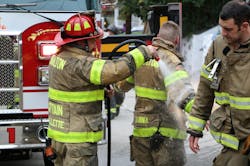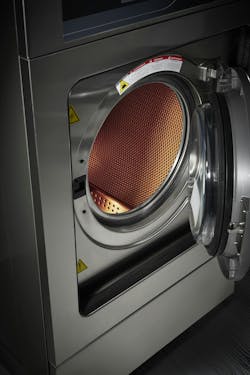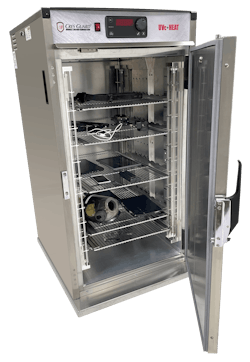Firefighter Decon: On the Fireground and at the Station
Key Takeaways
- A major hurdle to achieving the utmost awareness regarding cancer that’s tied to fighting fires is the lack of understanding of toxic hand-off, whereby firefighters bring carcinogens into their home.
- Efforts that are aimed at the neutralization of contaminants that are on firefighters’ turnout gear and other PPE immediately after a fire is put out helps to mitigate cross-contamination.
- Extractors that heat water to at least 105 degrees Fahrenheit solve the problem of lower temperatures that can result when a hot water tank is located in a remote location from the laundry area.
Without proper preemptive care and procedures, cancer can sneak up on a firefighter. Exposed more to toxins and carcinogens than the average citizen, they have a 9 percent higher risk of being diagnosed with cancer and a 14 percent higher risk of dying from cancer than the general U.S. population, according to research by the Centers for Disease Control and Prevention and National Institute for Occupational Safety and Health (NIOSH).
While the numbers rose over the past few years, proactiveness in the battle to prevent cancer in first responders also increased. From decontamination foam on scene for bunker gear to natural shampoo and body wash, the firefighter decon process has become more thorough.
Decon on scene
Even with numerous products that aid in reducing firefighter exposure to carcinogens having come out, the biggest hurdle seemingly is education. Informing members of the detriments to not properly cleaning their turnout gear and person is crucial.
That’s where Hygenall’s Firefighter’s Decon Certification Training Class comes in. The class rolled out in 2024 and explains a range of topics, from how chemicals stick to people, to where the chemicals originate, toxic hand-off and simple strategies to mitigate exposure.
The class’ format is either an online, 60-minute, live interactive course or an in-person session that’s led by Hygenall’s Firefighter Product Manager Michael McKinnon. From either, firefighters receive a Decon Training Certificate upon completion.
Although the company’s work started as military decon, Hygenall went to Chicago to perform surveys of stations, swabbing surfaces to test for carcinogens and other toxins. A step further was taken by going home with firefighters to swab their personal vehicles and their home environment.
The biggest issue was toxic hand-off. If not cleaned properly, firefighters can bring carcinogens into their home, exposing their spouse and children.
“We talk about how easy it is to mitigate this stuff, simply by following good hygiene practices,” McKinnon says. “We divide it up into three areas: the fireground, the fire station and the person.”
After the fire is put out
Raising awareness of hidden chemical dangers and best hygiene practices is a good start for departments that want to put their best foot forward in their decon efforts. A next step: looking at on-scene decon. Intelagard’s Doff ‘n Decon Foam is an option for that. After fire attack is concluded and before getting into the apparatus, firefighters can be sprayed down without taking anything off for 90 seconds to neutralize the toxins that might have attached to their turnout gear.
Designed by Sandia National Laboratories and Intelagard President Dennis Smagac and working with the military, NFPA, UL Laboratories and others, Intelagard’s decon foam is certified by the Environmental Protection Agency as having no forever-chemicals in it. The goal is to shorten the dwell time of carcinogens.
Cross-contamination is mitigated, while the gear’s life is extended by 1–3 years.
At the firehouse
The decon process after firefighters return to the station is just as crucial. Washing turnout gear is where most of the mitigation of carcinogens happens. Ram Air Gear Dryer’s extractor with a heated drum was introduced in April 2025 to help to improve the efficacy of cleaning turnout gear.
The heated drum keeps the water at 105 degrees Fahrenheit for the entire prewash and main wash cycles. This solves a problem that some departments encounter when the station’s hot water tank is located away from its extractors. Washing in hotter water aids in the process of eliminating a lot of the toxins that are connected to the turnout gear. The company also is working with UL Laboratories to test its extractor with different detergents.
Ram Air Gear Dryer President Lance Dornn explains that the company wants to give empirical evidence to departments that if they use hot water, the cleaning process is going to be this much better.
Viruses and bacteria
To take cleaning turnout gear to another level, Cres Cor developed its Mobile Decontamination Moist Heat and Mobile Decontamination UVC + Heat units.
PPE that’s placed in the Mobile Decontamination Moist Heat sits at 185 degrees F at 65 percent relative humidity for 15 minutes to eradicate 99.9999 percent of extremely resistant viruses and bacteria.
The Mobile Decontamination UVC + Heat is designed for moisture-sensitive equipment and electronics. Because batteries start to falter at 140 degrees F, the unit operates at 120 degrees F.
Cres Cor’s expertise initially applied to the food service industry. When COVID-19 hit, the company and its product marketing manager, Yogesh Ramadoss, recognized the necessity for diversification. With the need to disinfect N95 masks during the pandemic, Cres Cor partnered with university hospitals in Cleveland to do testing. From there, a pairing with NIOSH and others happened, which led to a connection with the U.S. Food and Drug Administration. The company started to talk to fire departments about how Cres Cor units could be altered to help to clean turnout gear and electronics.
“Electronics are things that never get washed,” Ramadoss says, “but they're always on the scene, exposed to everything and shared assets. What we're introducing is a complementary process to reduce biologicals at the entry point.”
The Concord Township, OH, Fire Department (CFD) helped to pilot the two units. Its feedback was considered in the design of the equipment.
“We have a whole room dedicated to decontamination,” CFD Fire Chief Matt Sabo tells Firehouse. “We were excited about the units. It's about taking care of the firefighter and taking care of the families.”
Hygiene & decon
Although decontaminating turnout gear and other equipment is important, so, too, is cleaning the actual firefighter. With FLAME Natural Decon’s shampoo and body wash, carcinogens can be removed from the skin.
Founder Tara Cornett decided to dive into firefighter decon because her brother works for the San Diego Fire Department. She wanted to provide a natural product that would be an easy implementation into the decon process.
“Before I came up with this product, there were products out there to clean the apparatus, gear and stations,” Cornett notes, “but who gets cancer? The firefighter.”
Cornett says that she found a scarcity of products to clean the firefighter to remove carcinogens to the point of nondetectable.
FLAME Natural Decon’s shampoo and body wash now are utilized in more than 200 departments. They are composed of naturally derived ingredients and come in multiple fragrances.
To remove a carcinogen with activated charcoal, you must get that carcinogen close to the activated charcoal. It draws it in and washes it away. Different carcinogens have different sizes, and the products’ proprietary blend of activated charcoal allows for the variance to apply to those different-sized carcinogens and wash them away.
Battalion Chief Stan Frierson of the Birmingham, AL, Fire and Rescue Service (BFRS) found that facet of the products compelling. All 32 BFRS stations have shampoo and body wash dispensers in their showers that are filled with FLAME Natural Decon’s products.
Education and tools
According to the International Association of Fire Chiefs, 66 percent of career firefighter line-of-duty deaths from 2002–2019 were caused by cancer. That said, firefighters can be safer on scene, at the station and at home. It all circles back to the education—of carcinogens and the decon products that are available.
About the Author

Ryan Baker
Ryan Baker is a writer and associate editor with prior experiences in online and print production. Ryan is an associate editor for Firehouse with a master's degree in sciences of communication from the University of Wisconsin-Whitewater. He recently completed a year of teaching Intro to Public Speaking at UW-Whitewater, as part of his graduate program. Ryan acquired his bachelor's degree in journalism in 2023 from UW-Whitewater, and operates currently out of Minneapolis, MN. Baker, also writes freelances for the Ultimate Frisbee Association (UFA) in his free time, while also umpiring baseball for various ages across the Twin Cities Metro Area.


